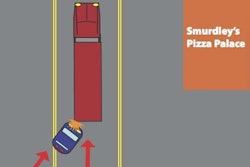With more than 40-plus lubrication points on the chassis alone, greasing a commercial truck is a labor-intense process.
Electrically controlled automatic lube systems – a popular add-on to trucks in Europe whose popularity is growing in the U.S. – ensure lubrication points periodically get a small doses of fresh grease by dispensing it at regular intervals.
“The biggest advantage of an automatic grease dispensing system is that the lubrication points periodically get a small amount of fresh grease, containing fresh oil and additives, much more often than just at the service interval,” says Steven Bowels, Sr. Lubes Product Specialist, at CITGO.
“When it comes to re-lubricating grease joints, a little bit a grease more frequent is better than a lot of grease less frequently,” adds Stede Granger, OEM technical services manager for Shell Lubricants.
Automatic systems also allow for lubrication while the truck is moving, an impossible task when done manually.
Grease jobs are typically assigned to the newest technician on the shop floor, or to employees with the least amount of experience. Automatic systems take that lack of expertise out of the equation.
“It’s something else to maintain but it can be a valuable piece, especially if you’re extending drains,” says ExxonMobil CVL Applications Engineer Paul Cigala. “It’s one less thing your mechanics have to worry about.”
Automatic lube systems may give a shop one less thing to deal with but Ron LeBlanc, Sr., senior technical advisor at Petro-Canada Lubricants, says they are far from a “set it and forget it” solution.
“If an automatic lube system is monitored regularly it can be beneficial for fleet owners. However, if it’s forgotten it can present problems,” he says. “It’s important for fleet owners to invest in quality solutions for lubricants, greases and automatic lube systems to ensure proper lubrication and protection of their fleets.”
An automatic lubrication system consists of injectors or valves, a pump, controller, tubing and fittings that connect to the lubrication points. That entire network needs occasional spot checks to ensure it’s working as designed.
“If you see an injector that’s not applying grease, you have to take care of that because it will cause a failure of that part,” Cigala adds.
James Booth, Chevron Lubricants North America Commercial Sector Manager, says there are pros and cons for automatic lube systems. On the positive side, he says the right amount of grease can be set to re-lubricate your equipment at the right time consistently. However, it requires effort to calibrate, monitor and maintain the system as the seasonal temperatures still need to be considered, potentially requiring greases be adequately changed to lubricate the system to flow through the auto lubricator reliably.
“The negatives can be costs, if the system isn’t set up and maintained to maximize the benefits,” he adds. “Additionally, the mechanic may not inspect the equipment frequently enough to notice imminent issues in need of repair.”
The automation of a manual process, Granger says, can have the unintended side effect of taking a technician’s eyes and attention off parts – like slack adjustors or king pins – where failure could be costly if not catastrophic.
“The thing I like about manual grease re-lubrication is it gives the technician a reason to get under the vehicle,” he says. “While you’re under there you can actually be proactive and discover things that are happening. I just find that getting under the vehicle every so often and keeping your eyes open is very worthwhile. A lot of mechanical failures always give warnings first.”
Part of properly lubricating a component, Cigala adds, is actually seeing the new grease flush out the old, along with any other contaminants. That’s something an automatic system can’t monitor.
“[Proper lubrication],” Cigala adds, “is making sure you’re seeing the old product being pushed out, [along with] any kind of metals, any kind of moisture, any kind of dirt.”












